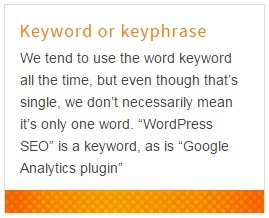

What’s the difference between your brand and your keywords? Are you using both effectively? Your brand is one of your most important keywords, but it shouldn’t be your only keyword, nor should you have lots of keywords but no brand. There should be a keyword strategy behind the keywords you pick. This post highlights the why of that and explains the basis of the how, then points you to several useful posts for the how.
Michiel recently wrote about Homepage SEO, telling people not to try and rank their homepage for a specific keyword. In the comments there were clearly some misconceptions about how branding relates to your keyword strategy. We’ve been writing a lot about keyword research lately but we’ve not talked about keyword strategy much, so this post elaborates on what these are and how they connect to each other.
Branding and Your Homepage
There’s one page that’s by far the most important in terms of our and your branding: the homepage. Your homepage has one task, and one task only from an SEO perspective: to rank for your brand. I can think of no meaningful website where this should be different.
Branding Truly is Branding
But what is branding? The term branding stems from the literal act of branding cattle with a hot brand. You “mark your ownership” by branding a cow. You can “own” a product group too by putting your brand on it.
Our brand is “Yoast”. It’s not “WordPress SEO”, nor is it “Google Analytics”. Those are keywords. We have one brand and we’ve slowly moved all our product names to be completely branded too, instead of generic. You might have noticed our WordPress SEO plugin is now called WordPress SEO by Yoast and the same is true for our Google Analytics plugin, which is calledGoogle Analytics by Yoast.
These are deliberate decisions, not happenstance. In the past, and sometimes even today, choosing generic product names or even generic keyword domains would’ve gotten you quick and easy rankings in the search engines. The question you have to ask yourself is: if I do this right, will people remember my brand?
By branding our products, we can even make people aware of our brand right when they’re searching. For instance, when people search for WordPress SEO in Google, this is the suggest box they’ll see:

You’ll understand that this strengthens our position in a way that could never happen if our product had a purely generic name.
Keyword Domains
Because of our idea that you should have one brand and several (hundreds) keywords, we’re not big fans of keyword domains at Yoast either. By using a keyword domain you bind your companies past, present and future to a single keyword. And with the abundance of new top level domains (TLDs) now available, you’ll have a very hard time buying all of the TLDs with the same keyword to keep out the competition.
No single website, or worse, company should rely on a single keyword for its traffic. You need a more solid base. You need a keyword strategy!
Keyword Strategy
Your keyword strategy should make clear which “keyword groups” you focus on. It doesn’t have to be a long list of keywords (though it doesn’t hurt to have one). Your keyword strategy should be a definition of a group of keywords that you’re tackling. Every time you’re writing new content you can have a quick look at those groups and pick a new keyword that falls in line with the strategy.
These keyword groups should be inter-related too of course; if you can never write posts that touch on multiple of your main subjects, they’re simply to far apart.
The main questions you should ask yourselves are simple:
- What are people searching for when they should be finding me?
- What question does my product or service answer, which problem does it solve?
We’ve got more of this in our ebook. You should then take two steps with the keywords you come up with:
Step 1: How Many Keywords Should I Target?
While I can’t answer that question directly and equally for every organization and website, I can say a couple of things: 1, 5 or 10 keywords: that’s always too little. Broaden your horizon a bit and/or dive deeper into the long tail.
1,000+ keywords: if it’s just you or 2 of you, this is probably more than you can chew off. It’s not hard to gather 1,000 keywords though, so if you’ve got the time, the people and the inspiration, it usually does pay off to write a lot of meaningful content. Do make sure that all those keywords relate to your products or services as otherwise it’s nonsense and make sure that you’re structuring your site well around it.
So, even if you’re a reasonably small business, you’ll probably end up with a couple of hundred keywords. But you don’t have to have pages for all of these immediately. The great thing about having a CMS like WordPress is that you can incrementally add content.
Step 2: Head or Tail?
It’s important to classify your keywords. You should distinguish your most important high level keywords, the ones that have sufficient traffic for your business and connect the best to your business. These are usually more “head” than “tail”. You should only have a few of these keywords for your business. The rest of it are bound to be more down the tail. If you don’t know what I’m talking about, go read up on long tail keywords.
I always tell people to think of their site as a pyramid. Your brand is at the very top, below that is your cornerstone content for your “head: keywords, the keywords you care about the most, below those are dozens – if not hundreds or thousands – of pages, strengthening your site’s structure. I wrote about site structure & SEO over 3 years ago but it still rings true. We wrote about both these topics in our ebook too.
If you have trouble coming up with more than a few keywords, try some of thekeyword research tools Marieke wrote about recently
[“source-searchenginejournal”]

